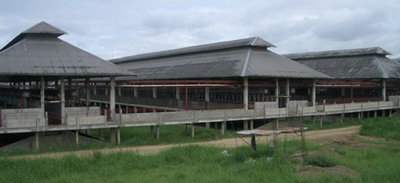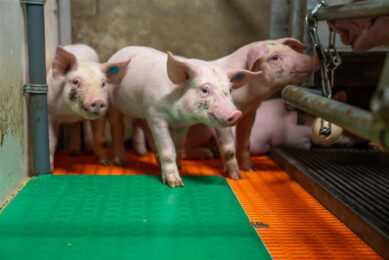PCV2 vaccination changing the pig industry – Part 2. Global experiences from the field around one-shot vaccination

The latest reports from around the world confirm that PCV2 vaccination is bringing major benefits under various climatic, feeding and management conditions. Here is a comprehensive overview of global results related to one-shot PCV2 vaccination.
©
©
©
©
By Dr K. Siebel, pig farm consultant; Germany
©
One of the most extraordinary success stories of pig health control has happened internationally in the last three years. A technique that was not commercially available anywhere until 2006 – and in several places did not reach the market until last year – is already protecting the health and growth performance of many millions of pigs around the world. No less importantly, the results at farm level show that it is more than fulfilling its promise to be extremely cost-effective.
©
This article is all about vaccinating pigs and in particular the successful application of vaccine use against the diseases of major economic importance associated with the porcine circovirus type 2 (PCV2). Business press reports say that world sales of PCV2 vaccines in 2008 reached the total of US$265 million. At that level they accounted for almost one-third of the global pig vaccine market in value terms.
©
Faced with a choice of applications, most farms selected the option of vaccinating piglets with a single dose around weaning. Based on available trial information this paper is reviewing the facts and fiction of one-shot PCV2 vaccination. For all trial results in this article, the PCV2 vaccine Ingelvac Circoflex was used, manufactured by Boehringer Ingelheim Animal Health.
©
©
Discussion and conclusions
PCV2 is still most widely known as the principal factor behind the high mortality and growth checks of the post-weaning multisystemic wasting syndrome (PMWS). First described in Canada in 1991, PMWS has become recognised universally as a serious threat to the viability of affected farms, with the potential to erupt in young pigs at any stage between about five weeks and 15 weeks of age.
©
But PCV2 is now also being linked to a wider range of disease syndromes in pigs. These are often considered together under the label of porcine circovirus diseases (PCVD). In addition to various clinical manifestations involving morbidity and mortalities, the infection is of great concern in commercial pork production because of its highly damaging effects on growth performance.
©
©
The high percentage of pigs vaccinated with PCV2 vaccines in many markets©(Table 1) add to the story by demonstrating that the value of PCV2 vaccination has been seen around the world. Whether in North America, in Europe or in Asia, despite their obvious differences in disease situation and in the pig production systems, it is clear that PCV2-vaccinating has yielded some very welcome economic benefits to users.
©
©
American views
Jennifer Arnold and others reported a North American example to the American Association of Swine Veterinarians (AASV) in 2008. It©described how pigs of three weeks were vaccinated with a one-shot regime to control clinical PCVD in a US production system that had suffered over 10% mortality between weaning and finishing. The vaccinated pigs showed significantly less disease associated with PCV2. Fewer pigs died or were culled, feed efficiency improved and the average daily gain registered a significant improvement from 650 grammes to 675 g/day. The ratio between financial benefit and cost was 5.7:1.
©
©
A report by Dr Robert Desrosiers and others to the Journal of Swine Health and Production has referred to one-dose vaccination with the same product, given to weaned pigs on a multi-site system of 1,300 sows in Canada where costly PCVD problems had occurred for the previous 18 months. In all four finishing barns tested, death losses were significantly lower in vaccinates than in controls. The investigators took a weighted average, representing the number of pigs that died in the four barns divided by the total pigs introduced, and found a mortality rate of only 2.4% for the vaccinated pigs compared with 9.5% for the controls.
©
The 2009 SafePork conference held in Québec heard about a retrospective analysis of production data from a high-health unit of 2,800 sows in western Canada, performed by Egan Brockhoff, DVM and others. After it implemented a PCV2 vaccination, the herd’s average daily weight gain improved from 845 grammes to 913 grammes and the average mortality rate was reduced from 5.5% to only 2.1%. At the same time, there was a reduction in the unit’s use of antibiotics that saw its average antibiotic cost per pig fall from CAD$1.20 to CAD$0.42.
©
©
For Latin America, the 20th IPVS congress heard about the vaccine’s use at a single-site system of 4,200 sows in Chile in a research carried out by A. Ramírez and others, resulting in a thirteen-fold decrease in the mortality rate during the nursery phase up to 70 days of age. Extra uniformity within batches was also observed. Other evidence from the same Chilean farm was presented to the Leman Swine Health Conference in 2008 and followed pigs from about ten weeks old until slaughter weight. When marketed at 169-170 days, control pigs weighed only 103.1 kilogrammes on average whereas the vaccinated animals had a final weight average of 112.3 kg.
©
©
European views
A 2008 report by Vicky Fachinger and others in the journal Vaccine gave a European view when it described how vaccination at a German farm successfully controlled a problem with the porcine respiratory disease complex (PRDC) that had links to PCV2. The problem affected a growing-finishing farm which received 500 pigs every four weeks from an associated breeding herd. At first, it appeared to coincide with an infection of the PRRS virus. The pigs had started coughing at the middle to late finishing stage.
©
©
Performance records between the ages of ten weeks and 25 weeks revealed an increase in mortality rate from 1-2% to 3-5% with the onset of PRDC, in addition to a relatively low average weight gain of 750-780 grammes. However, the significant improvement of overall growth performance of vaccinated pigs in this study demonstrates the benefits of PCV2 vaccination in the presence of a multi-factorial, late occurring disease complex like PRDC.
©
©
At the aforementioned SafePork Conference in Québec, Canada, a research by Brons and others was presented, showing that the introduction of a one-shot vaccination regime vaccination at a 900-sow British herd had resulted in better performance with reduced antibiotics use. The average growth rate increased from 669 g/day to 729 g/day and the feed conversion ratio improved from 2.53 to 2.44. The total cost of veterinary fees per pig (advisory visits plus all antibiotics) dropped by over 22%, from £1.62 (€1.78) to £1.26 (€1.38) per pig. Most strikingly for the producer the PDNS related mortality, which was accountable for up to 60% of total post-weaning mortality, disappeared in all vaccinated pigs completely.
The proceedings of the 1st ESPHM pig health symposium held in Denmark include a paper from Italy by Marco Terreni and others. It reported that pigs from a 700-sow farm vaccinated at weaning with a single dose of vaccine retained their protective immunity for up to nine months after vaccination, when raised for Parma ham production.
©
©
Asian views
At a symposium held during the 2009 Asian Pig Veterinary Congress, Dr Jun Yako from the Northern Veterinary Clinic at Chiba in Japan reported a 12.4% decrease in the average post-weaning mortality rate of the Japanese prefecture’s pigs following the initiation of PCV2 vaccination in May 2008. Also, pigs vaccinated in the period September 2008 to March 2009 had been marketed 5.7 days earlier than pigs without vaccination.
Results from an investigation by A.C. Bulay and others in the Philippines were presented to the APVS Congress, demonstrating that the use of a single-shot PCV2 vaccine on a breeding to finishing unit of 2,300 sows increased the average weight of pigs marketed between 150-165 days old from 80 kg to 85.8 kg as well as increasing survival rates from the nursery stage onwards.
©
©
Among the many case-histories from different countries, however, one of the most notable was published last year in The Pig Journal. It came from a field study conducted by Isabelle von Richthofen and others in the United Kingdom to investigate the efficacy of one-shot PCV2 vaccination under commercial conditions of management and housing at a British finishing unit. For this study, pigs of two to three weeks of age were given either the vaccine or a placebo by injection. The animals were then co-mingled for the time from weaning until slaughter.
©
©
©
A significant difference in mortality rates was found. The overall death loss was 14.1% in the placebo-treated animals, but only 4.59% among the vaccinated pigs. Most deaths occurred after the onset of viraemia at 8-9 weeks of age. From this point until the end of the study period, the mortality rates for the groups differed by 74%. The death losses in the vaccinated group averaged just 3.32% against 12.99% for the placebo-treated group. Figure 1 from the same study deserves equal attention because it illustrates the results of check weighing of pigs at the ages of three weeks, ten weeks, 15 weeks and 23 weeks. Bodyweights for the two groups diverged from ten weeks, with an advantage to the pigs that had received the vaccine. By 23 weeks of age they weighed on average 6.8 kg more.
©
©
©
©
This was on a grower-to-finishing farm that had been chosen for study because of its disease pattern of clinical signs typical of PMWS and an associated increased mortality. Its pigs came from a farrowing farm in the same production system that sent 1,100-1,200 weaned piglets every three weeks. The study concluded that administering a single dose of the vaccine to piglets before weaning was efficacious in bringing the growing-finishing stage a marked reduction in mortality and in removing the growth retardation due to the circovirus infection.
Numerous studies, field trials and case-histories have now proved that one-shot vaccination of piglets around weaning is not only easy and convenient, it is also effective at protecting the pigs throughout their growing and finishing stages. A concise overview of all these figures can be found in Table 2.
©
©
One-shot vaccines Several companies have now launched a PCV2 vaccine; some of these can be administered in two shots, but another group is available for one-shot dosage. Market leader in the one-shot segment is Boehringer Ingelheim’s Ingelvac Circoflex. Its vaccine consists of a combination of purified circo-antigen and an adjuvant that has been developed for one-shot application, leading to an efficacious and well tolerated product. Additionally, the single vaccination around weaning allows an approach that is easy to administer and implement in existing vaccination programmes. Data in this article are based on this vaccine’s results throughout the world. |
©
©
©
©
***References available on request
©
PDF©VERSION©OF©ARTICLE:©PCV2 vaccination changing the pig industry
©
Source: Pig Progress No. 26.1©
©











